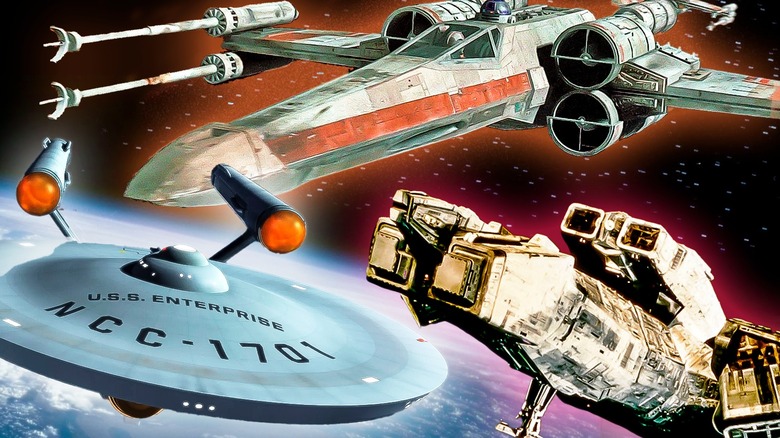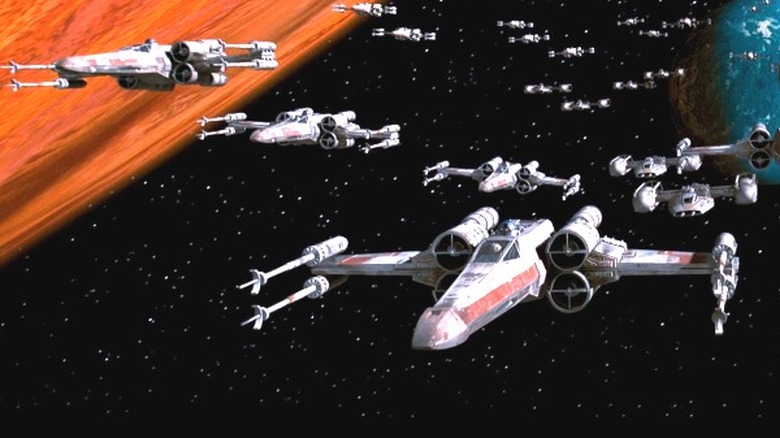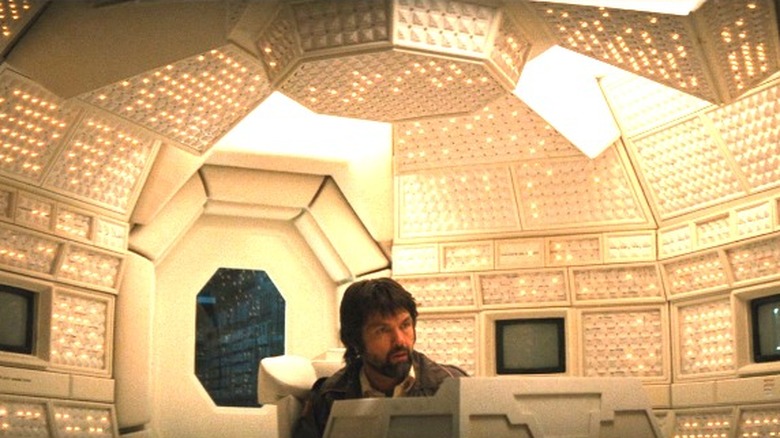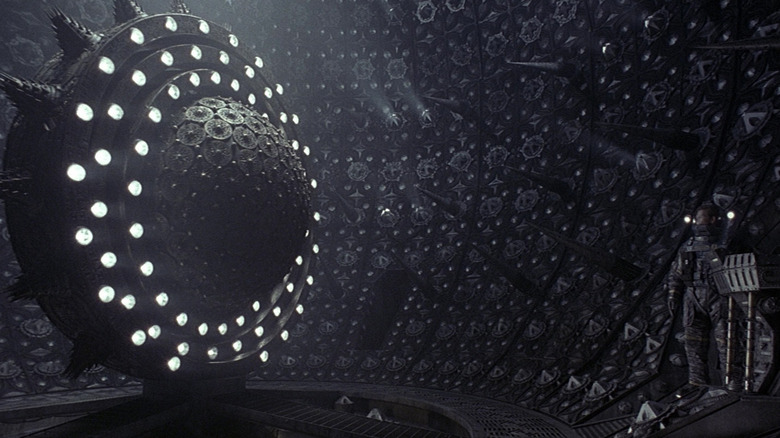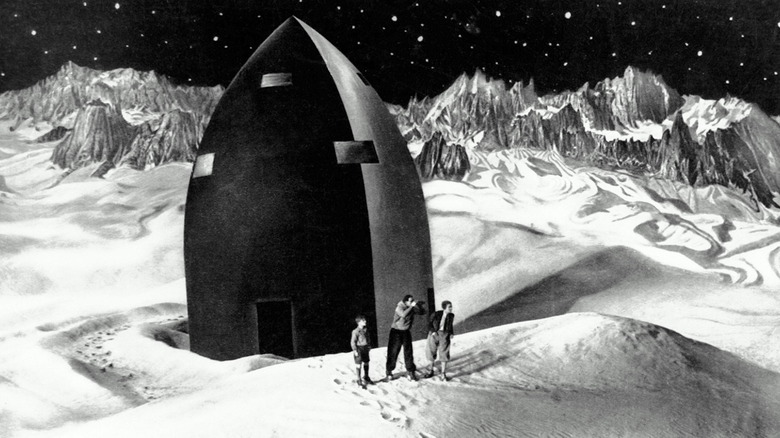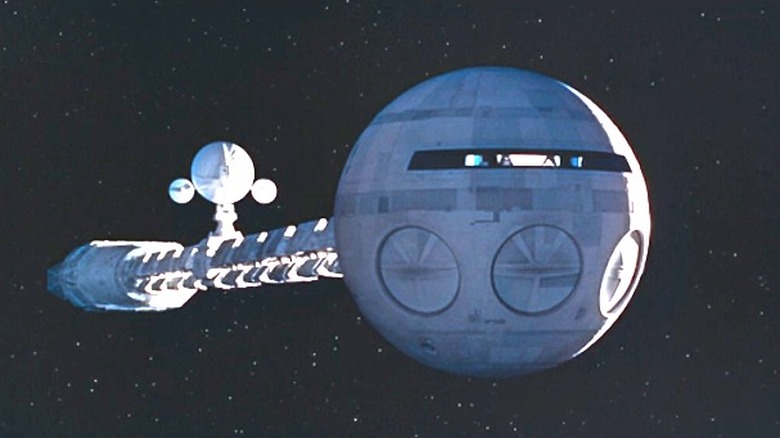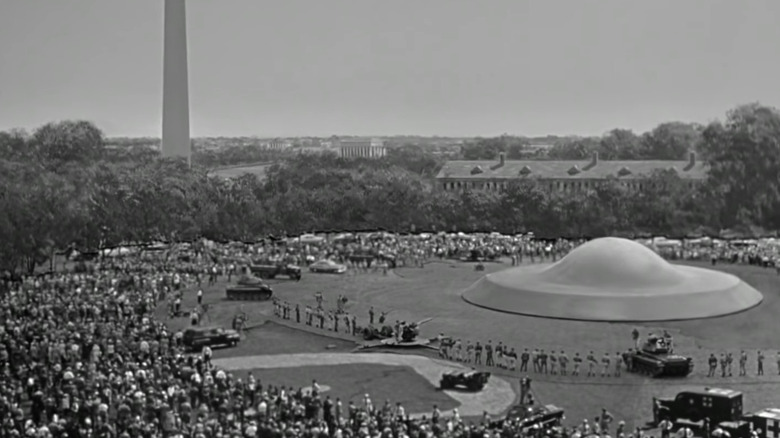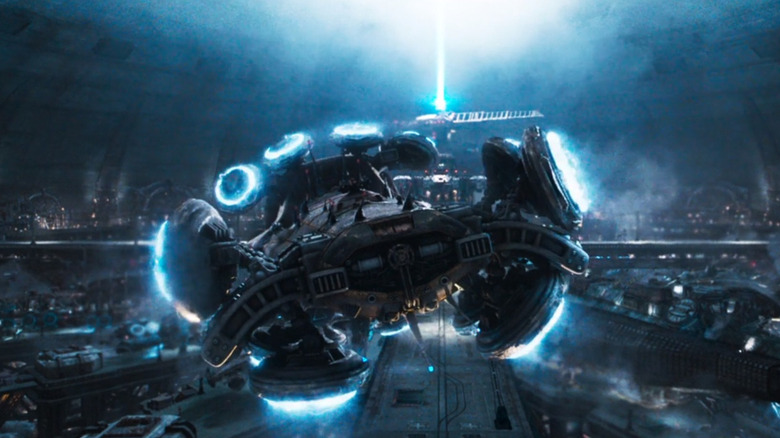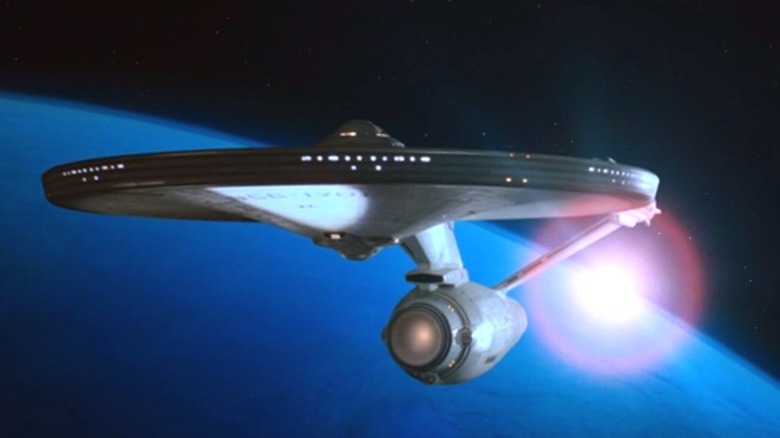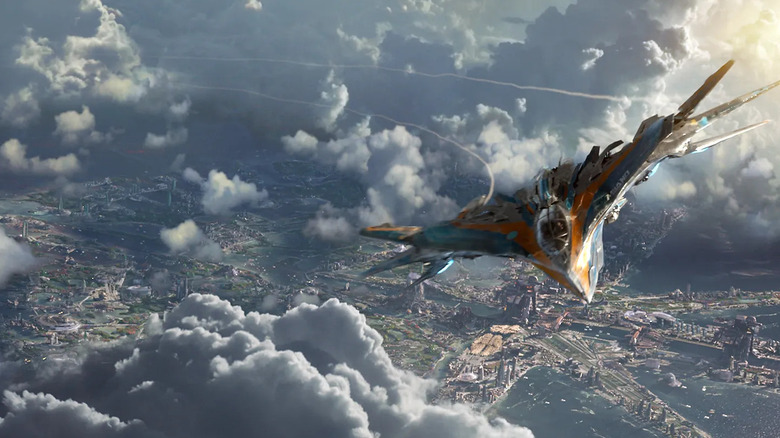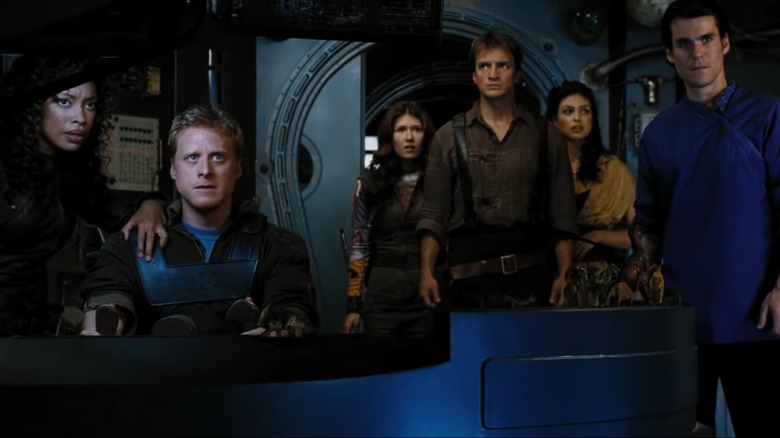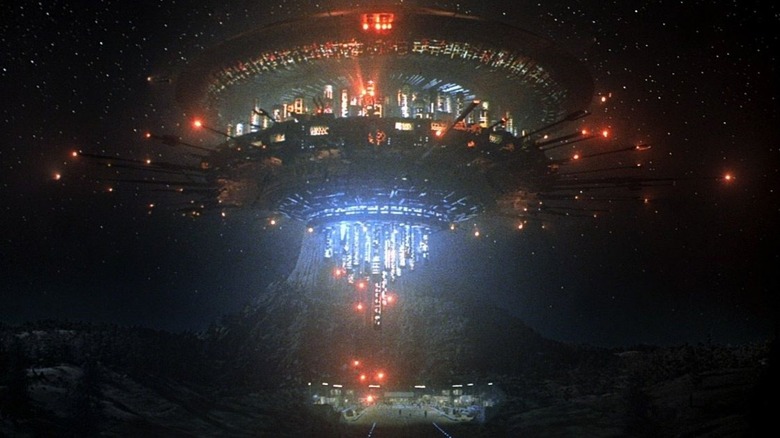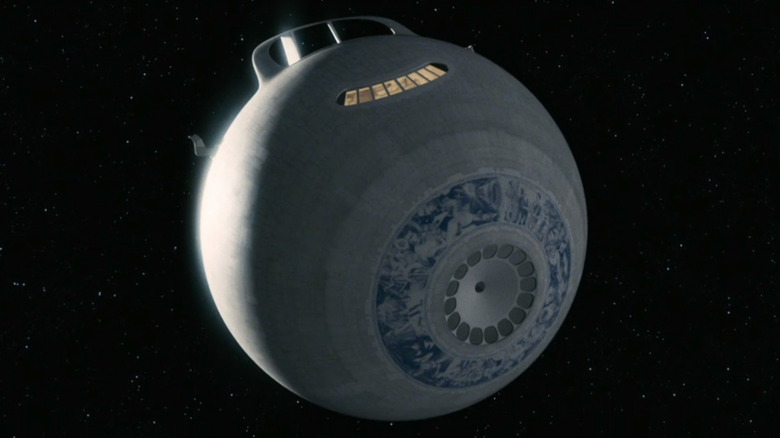The 12 Coolest Spaceships In Sci-Fi Movie History
The spaceship is one of the true hallmarks of the science fiction genre. Without these technological marvels, how else might we explore strange new worlds, seek out new life and new civilizations, and boldly go where no man has gone before? Yes, sci-fi is rife with spaceships of all kinds: capital ships, cruisers, fighters, freighters, yachts, rockets, space stations, escape pods, flying saucers, and pretty much anything else you can imagine. Despite their myriad differences, though, the majority are united by a single key attribute — they're all seriously cool.
But what actually makes a spaceship "cool?" Is it enough to give it a slick look and make it go fast? Well, a nice coat of paint certainly doesn't hurt, but it takes more than mere aesthetics to win the hearts of sci-fi fans. Spaceships might be considered cool because they show off unique abilities, play a compelling role in a story, or hold an important place in the genre's history. Naturally, the best of them all tick many of these boxes at once. So strap in, engage boosters, and get ready to jump to lightspeed: These are the 12 coolest spaceships in sci-fi movie history.
X-wing
"Wait," I hear you say, scanning through this list to see which spaceships made the cut. "Where's the Millennium Falcon? Surely you couldn't be so foolish as to omit cinema's most famous sci-fi spaceship?" The joke's on you, though, because I am absolutely that foolish. The Falcon is missing here for two reasons. Firstly, it's not even the coolest spaceship that looks similar to the Millennium Falcon in the "Star Wars" universe. Secondly, the original 1977 film features a far superior alternative: the X-wing.
In-universe, X-wings are swift and powerful starfighters that were originally made for use by the Imperial Navy, before the schematics fell into the hands of the Alliance to Restore the Republic. Originally designed by the legendary "2001: A Space Odyssey" and "Close Encounters of the Third Kind" concept artist Colin Cantwell, the X-wing has made countless appearances in sequels and spinoffs in the decades since the original "Star Wars." Today, it is widely recognized as one of the most iconic ships from the galaxy far, far away.
It's easy to see why, as well. Aside from having arguably the coolest name ever given to a sci-fi spaceship, the X-wing boasts a grimy, rag-tag look that stands in stark and effective contrast to the unsettling uniformity of the Empire's TIE fighters; it practically screams rebel chic. Throw in some unforgettable sound design and the fact that one blew up the whole damn Death Star, and you've got a spaceship like nothing else out there. Millennium what?
USCSS Nostromo
Ellen Ripley (Sigourney Weaver) and her Xenomorph nemesis might be the stars of Ridley Scott's 1979 sci-fi horror masterpiece, but a scary story is only as good as its setting — and "Alien" would be nothing without the USCSS Nostromo. Sure, it's not the fastest or strongest ship in the universe, and the crew aren't valiant soldiers or intrepid explorers; really, it's a glorified tugboat crewed by a handful of space truckers. Despite being about as ordinary as a spaceship can be, however, the Nostromo can be safely counted among the prettiest, creepiest, and coolest ships in the genre.
The Nostromo was designed by artists Ron Cobb and Chris Foss, but there's something unmistakably Gigeresque about its look. Inside that sharp, bulky exterior lies a labyrinth of hard angles, unnatural patterns, and strange tubes, giving the finished effect of a spaceship that looks almost like the Xeno itself, half-beautiful and half-terrifying. As the film draws on and the alien's rampage intensifies, the Nostromo seems to become even more claustrophobic and disorientating, while the machinations of the AI MOTHER and the heart-stopping tension of the final self-destruct sequence give the impression of a ship that is actively working against its crew. That's what makes the Nostromo so captivating, really: It's never overtly villainous, but it looks and feels totally hostile — kind of like a haunted house in space. Few sci-fi or horror movies have ever set the stage so effectively.
The Event Horizon
Sometimes, of course, a spacecraft can be overtly villainous, and none are as depraved as the Event Horizon. Early on in Paul W.S. Anderson's 1997 sci-fi horror "Event Horizon," the eponymous ship appears to be just that: a faster-than-light spaceship that disappeared, and then reappeared, under mysterious circumstances. Later, after everything starts to get a bit eye-gougey, it turns out that the Event Horizon gained sentience after briefly crossing over into another dimension, essentially becoming the science fiction equivalent of the Overlook Hotel.
Aesthetically, the Event Horizon owes much to the Nostromo, while the Gravity Drive that powers the ship is basically a straight-up rip-off of the Space Jockey chamber aboard the Derelict. Look past the visual similarities with "Alien," however, and you'll find a ship that is scarier and more dangerous than anything Ripley faced. For one thing, the Event Horizon's ability to hop between realities widens the scope of its terrible potential; Xenomorphs are scary, but the nightmarish dimensions beyond our own are another thing entirely. There's also something to be said for the unbridled, balls-to-the-wall barbarity of the Event Horizon's dark side. This is a ship that will put hell inside your head, turning your fears against you and forcing you to murder your friends and colleagues. And therein lies the coolness: How many other spaceships can be counted among the greatest sci-fi villains of all time, too?
Friede
Friede might not look like much to a 21st-century audience. The spacecraft in Fritz Lang and Thea von Harbou's 1929 silent film "Woman in the Moon" is essentially the archetypal depiction of a rocket ship. In the film – and the novel on which it was based – Friede carries Helius (Willy Fritsch), Professor Mannfeldt (Klaus Pohl), and their team of explorers on a fantastic journey to search for gold on the lunar surface. So far, so ordinary, right?
Friede is so much more than that, though, and the ship's influence on both cinema and real-world space travel is nothing less than astonishing. "Woman in the Moon" was the first motion picture in history to make use of a scientific advisor, resulting in a portrayal of rocket travel that was so realistic that the Nazis later banned the film, at least in part because they were frightened their enemies could mine it for secrets about the V2 program. The collaboration between Lang, von Harbou, and physicist Hermann von Oberth produced a spaceship that foretold multiple innovations in space exploration, including countdowns, flooded launchpads, and multistage rocket flights. Watching "Woman in the Moon" nowadays, these rituals might make Friede's voyage seem a little humdrum, especially in comparison to the fantastical twists on spaceflight that we've seen in the years since; in truth, the film was laying the foundations for a century of innovation. Amazing, no?
Discovery One
Discovery One is the pivotal spacecraft in Stanley Kubrick's 1968 sci-fi masterpiece "2001: A Space Odyssey." Crewed by Dave Bowman (Keir Dullea) and his fellow astronauts, the ship's mission to Jupiter is thrown into disarray when a certain red-eyed computer begins to malfunction.
It's hard not to notice that Discovery One's exterior isn't exactly a style phenomenon, what with it looking a bit like a giant sperm (which may not be an accident, considering the film's themes of conception, birth, and evolution). That said, the gleaming-white interior is much more attractive, and it has clearly influenced countless films over the years, from "Alien" to "Star Wars" to "Moon." Credit is also due for the design of the centrifuge that gives the ship its artificial gravity, a 38-foot, 30-ton rotating set that cost Kubrick and his crew $750,000 to build — around $6.5 million today. Centrifugal force is nothing new to theoretical space travel, having been touted as a method of simulating gravity since as far back as 1914, but to see one crafted so magnificently is really quite remarkable.
And then there's HAL 9000. The sinister AI supercomputer that controls Discovery One's systems is by far the most insidious presence in "2001," despite only appearing as a small, red eye on a camera lens. HAL's eerily calm voice, demonstrable intelligence, and psychopathic disregard for the lives of the ship's crew coalesce to foster an all-time great villain, turning a merely cool spaceship concept into the stuff of absolute nightmares.
Klaatu's flying saucer
By the early 1950s, the term "flying saucer" was firmly rooted in the science fiction lexicon. The UFO craze had kicked off in 1947, when reports of flying saucers spread across the United States, and they had been cropping up in pulp magazines like "Amazing Stories" for at least a year before that. 1950 saw the first on-screen depiction of a flying saucer in the sci-fi drama "The Flying Saucer," but it was "The Day the Earth Stood Still," released a year later, which truly marked the advent of UFO cinema.
Like so many trailblazing moments in 20th-century filmmaking, the arrival of Klaatu's (Michael Rennie) flying saucer in "The Day the Earth Stood Still" feels like a tired cliché nowadays: It soars over Washington D.C., passing landmarks such as Capitol Hill and the Washington Monument, while innocent citizens flee in terror. At last, the glowing, pulsating spaceship touches down on a baseball field; a crowd of soldiers and on-lookers gather around as a ramp lowers, a door opens, and Klaatu steps out to greet them.
The design of the ship itself is a faithful recreation of the strange discs that had thrilled the world in 1947, and you can only imagine the excitement audiences must have felt at seeing it portrayed on-screen in all its glory. Of course, we now know that the flying discs of '47 were essentially the product of a bout of mass hysteria, but that doesn't make Klaatu's flight any less of a seminal moment in Hollywood's history. Indeed, without this scene, it's fair to say that we would likely never have gotten "Independence Day," "E.T. the Extra-Terrestrial," or "Close Encounters of the Third Kind." Klaatu barada nikto!
The Nebuchadnezzar
Okay, maybe I'm pushing the definition of "spaceship" with the Nebuchadnezzar since it's a hovercraft that never once emerges from beneath the Earth. "The Matrix" is undoubtedly sci-fi, though, and the Neb is as cool as it gets — so I think we can probably let it slide.
The Nebuchadnezzar is Morpheus' (Laurence Fishburne) ship in "The Matrix" and "The Matrix Reloaded." Sadly, it takes quite a beating over the course of those two movies. In the first, most of the crew are wiped out after Cypher's (Joe Pantoliano) betrayal, while the ship itself is severely damaged in an ensuing sentinel attack. Then, at the end of "The Matrix Reloaded," the Neb is destroyed for good by a tow bomb, though not before Morpheus bids it a tearful farewell. "Gone too soon" doesn't begin to cut it.
If you've seen "The Matrix," then you'll know why the Nebuchadnezzar has made this list. Morpheus' ship features a bold visual design driven by the same hodgepodge rebel style that makes the X-wing so appealing, while the decision to make it a hovercraft both underscores the grim desperation of Zion's rebellion and provides an excuse to stick a bunch of awesome buzzing glowing thingies all over it. (What, do I look like a hovercraft engineer?) The Neb is also crewed by some of the coolest characters in modern sci-fi: Morpheus, Neo (Keanu Reeves), and Trinity (Carrie-Anne Moss) go without saying, but the other members of the team are gun-toting, Matrix-hacking, leather-sporting heroes in themselves. Except Cypher.
USS Enterprise
You won't find an Earthling around who doesn't recognize the USS Enterprise. Nearly 60 years of "Star Trek" television and movies have helped cement the design of Gene Rodenberry's flagship into science fiction legend.
As you're probably aware, the Enterprise was first designed for "Star Trek," the original series that ran from 1966 to 1969. The ship was devised by the show's art director, Matt Jeffries, who was told by Roddenberry that it was not to feature any rockets, jets, fins, wings, or firestreams under any circumstances. The result? A sleek, graceful spaceship that owes as much to the stories of the past — specifically, the flying saucers of the '40s and '50s — as it does to the wonders of the future. And while small adjustments have been made during the franchise's long history, often to the chagrin of hardened Trekkies, it speaks volumes that Jeffries' original design has endured into the 21st century.
The only thing cooler than the Enterprise's look is its purpose: Unlike so many of its pop culture contemporaries, this ship isn't built to kill or destroy, but to reach out beyond the stars. While Captain Kirk (William Shatner) and his crew obviously find themselves in a spot of bother every now and again, the basis of their five-year mission represents the best of both "Star Trek" and the sci-fi genre. It's as pure a portrayal of mankind's boundless curiosity and longing for connection as has ever been told.
The Milano
The Guardians of the Galaxy have called three different spaceships home during their time in the Marvel Cinematic Universe: the Milano, the Benatar, and the Bowie. All of these ships are pretty cool in their own way, but I'd argue that the Milano just about pips its younger siblings.
The Milano is an M-Ship, a kind of space-faring pirate ship commonly used by the Ravagers; in "Guardians of the Galaxy," Peter Quill (Chris Pratt) mentions that he has been flying it since he was 10 years old. Named for Quill's childhood crush, Alyssa Milano, it's a smaller vessel than the Benatar or the Bowie, but what it loses in size, it more than makes up for in style and agility.
Honestly, the Milano is by far the coolest spaceship design to have come out of superhero cinema: Like a bird of prey in flight, this nimble blue-and-gold fighter is as capable of fleeing pursuing enemies as it is leading the Xandarian fleet into battle, and it's not hard to imagine Star-Lord piloting it into all kinds of trouble during his youth. That's the essence of its appeal — everyone knows that space pirates are cool, and the Milano is a space pirate's dream. Oh, and how many other sci-fi spaceships have their own custom-made tape deck? I'll tell you: none.
Serenity
Serenity is another spaceship with roots in the world of television. The prized possession of space scoundrel Mal Reynolds (Nathon Fillion), Serenity is a constant and comforting presence throughout the first — and only – season of "Firefly," as well as the 2005 movie "Serenity." It's also the home of Mal's crew and chosen family, including its pilot, Wash (Alan Tudyk), and mechanic, Kaylee (Jewel Staite).
Much of Serenity's charm relies on Mal's unequivocal devotion to his ship. As he tells River Tam (Summer Glau) at the end of "Serenity," the first rule of flying is love: "You can learn all the math in the 'verse, but you take a boat in the air you don't love, she'll shake you off just as sure as the turning of worlds." Luckily, Fillion absolutely sells his affection for Serenity in both "Firefly" and "Serenity," leaving you in no doubt that this hunk of junk is worthy of your affection, too. It helps that Serenity's interior is laid out more like a home than a spaceship, with particular focus on the galley, the crew quarters, and the docking bay — which is the perfect setting for the occasional armed stand-off or game of not-basketball. Yes, there are faster, fancier, and deadlier ships out there, but, as Mal himself would attest, none are easier to love than Serenity.
The mothership
The mothership from Steven Spielberg's 1977 sci-fi classic "Close Encounters of the Third Kind" clearly evokes memories of the real-life (well, sort of) "mother saucers" that had gripped the public's imagination a few decades earlier — except bigger, better, and cooler in basically every way.
Much of the movie revolves around sightings of smaller UFOs, but the "Close Encounters" ending sees the visitors' mothership descend on Devils Tower, startling the crowd of scientists and government officials who have gathered to meet them. The mothership itself is probably the prettiest spaceship in cinema, an immense, gorgeous symphony of light and sound that looks more like a floating city than anything else. The ship's aesthetic allure is only accentuated by its mesmerizing, colorful lights and remarkable manner of communication: the power of music.
I'd be remiss if I didn't mention the litany of references found on the mothership's model, too. Built by a team led by model maker Gregory Jein, the miniature used in "Close Encounters" features a number of details that were never intended to be seen on-screen, including a shark, a U.S. mailbox, a cemetery, a Volkswagen campervan, and R2-D2. You've gotta love an Easter egg.
The Heart of Gold
Don't be fooled by the Heart of Gold's appearance. Although it may look like Discovery One with its tail chopped off, this spaceship is perhaps the most brilliant product of Douglas Adams' planet-sized mind.
In "Hitchhiker's Guide to the Galaxy," the 1970s television series, and the 2005 film adaptation, the Heart of Gold is a state-of-the-art ship captained by Zaphod Beeblebrox, president of the galaxy. During the Heart's launch ceremony, Zaphod kidnaps himself, commandeers the vessel, and uses it to embark on a wild trip to the ancient world of Magrathea — stopping to pick up a few hitchhikers along the way, of course. In the novel and the series, the Heart of Gold is reminiscent of a long, cosmic running shoe, while the movie opts for a more bulbous, spherical design. That doesn't really matter, though, as the true heart of the Heart lies within.
The ship is distinct in the "Hitchhiker's" galaxy for its engine, the Infinite Improbability Drive. Made to facilitate space travel without any "tedious mucking about in hyperspace," the drive builds to a point of infinite improbability and forces the ship through every point in every universe at once. In the process, it can briefly alter the ship's environment, turn the crew into different objects or species, and make wholesale changes to the nature of reality. Only a literary tour de force like Adams could come up with such a bizarre plot device — and give science fiction one of the weirdest, funniest spaceships ever conceived.
